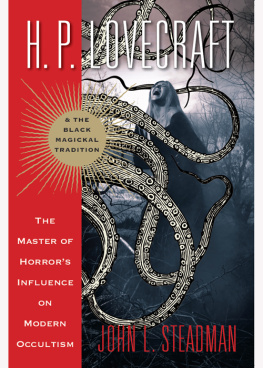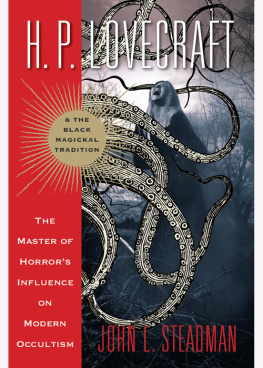Howard Lovecraft - The Picture in the House
Here you can read online Howard Lovecraft - The Picture in the House full text of the book (entire story) in english for free. Download pdf and epub, get meaning, cover and reviews about this ebook. genre: Science fiction. Description of the work, (preface) as well as reviews are available. Best literature library LitArk.com created for fans of good reading and offers a wide selection of genres:
Romance novel
Science fiction
Adventure
Detective
Science
History
Home and family
Prose
Art
Politics
Computer
Non-fiction
Religion
Business
Children
Humor
Choose a favorite category and find really read worthwhile books. Enjoy immersion in the world of imagination, feel the emotions of the characters or learn something new for yourself, make an fascinating discovery.

- Book:The Picture in the House
- Author:
- Genre:
- Rating:5 / 5
- Favourites:Add to favourites
- Your mark:
- 100
- 1
- 2
- 3
- 4
- 5
The Picture in the House: summary, description and annotation
We offer to read an annotation, description, summary or preface (depends on what the author of the book "The Picture in the House" wrote himself). If you haven't found the necessary information about the book — write in the comments, we will try to find it.
The Picture in the House — read online for free the complete book (whole text) full work
Below is the text of the book, divided by pages. System saving the place of the last page read, allows you to conveniently read the book "The Picture in the House" online for free, without having to search again every time where you left off. Put a bookmark, and you can go to the page where you finished reading at any time.
Font size:
Interval:
Bookmark:
The Picture in he House
by Howard Philips Lovecraft
Searchers after horror haunt strange, far places. For them are the catacombs of Ptolemais, and the carven mausolea of the nightmare countries. They climb to the moonlit towers of ruined Rhine castles, and falter down black cobwebbed steps beneath the scattered stones of forgotten cities in Asia. The haunted wood and the desolate mountain are their shrines, and they linger around the sinister monoliths on uninhabited islands. But the true epicure in the terrible, to whom a new thrill of unutterable ghastliness is the chief end and justification of existence, esteems most of all the ancient, lonely farmhouses of backwoods New England ; for there the dark elements of strength, solitude, grotesqueness and ignorance combine to form the perfection of the hideous.
Most horrible of all sights are the little unpainted wooden houses remote from travelled ways, usually squatted upon some damp grassy slope or leaning against some gigantic outcropping of rock. Two hundred years and more they have leaned or squatted there, while the vines have crawled and the trees have swelled and spread. They are almost hidden now in lawless luxuriances of green and guardian shrouds of shadow; but the small-paned windows still stare shockingly, as if blinking through a lethal stupor which wards off madness by dulling the memory of unutterable things.
In such houses have dwelt generations of strange people, whose like the world has never seen. Seized with a gloomy and fanatical belief which exiled them from their kind, their ancestors sought the wilderness for freedom. There the scions of a conquering race indeed flourished free from the restrictions of their fellows, but cowered in an appalling slavery to the dismal phantasms of their own minds. Divorced from the enlightenment of civilization, the strength of these Puritans turned into singular channels; and in their isolation, morbid self-repression, and struggle for life with relentless Nature, there came to them dark furtive traits from the prehistoric depths of their cold Northern heritage. By necessity practical and by philosophy stern, these folks were not beautiful in their sins. Erring as all mortals must, they were forced by their rigid code to seek concealment above all else; so that they came to use less and less taste in what they concealed. Only the silent, sleepy, staring houses in the backwoods can tell all that has lain hidden since the early days, and they are not communicative, being loath to shake off the drowsiness which helps them forget. Sometimes one feels that it would be merciful to tear down these houses, for they must often dream.
It was to a time-battered edifice of this description that I was driven one afternoon in November, 1896, by a rain of such chilling copiousness that any shelter was preferable to exposure. I had been travelling for some time amongst the people of the Miskatonic Valley in quest of certain genealogical data; and from the remote, devious, and problematical nature of my course, had deemed it convenient to employ a bicycle despite the lateness of the season. Now I found myself upon an apparently abandoned road which I had chosen as the shortest cut to Arkham, overtaken by the storm at a point far from any town, and confronted with no refuge save the antique and repellent wooden building which blinked with bleared windows from between two huge leafless elms near the foot of a rocky hill. Distant though it is from the remnant of a road, this house none the less impressed me unfavorably the very moment I espied it. Honest, wholesome structures do not stare at travellers so slyly and hauntingly, and in my genealogical researches I had encountered legends of a century before which biased me against places of this kind. Yet the force of the elements was such as to overcome my scruples, and I did not hesitate to wheel my machine up the weedy rise to the closed door which seemed at once so suggestive and secretive.
I had somehow taken it for granted that the house was abandoned, yet as I approached it I was not so sure, for though the walks were indeed overgrown with weeds, they seemed to retain their nature a little too well to argue complete desertion. Therefore instead of trying the door I knocked, feeling as I did so a trepidation I could scarcely explain. As I waited on the rough, mossy rock which served as a door-step, I glanced at the neighboring windows and the panes of the transom above me, and noticed that although old, rattling, and almost opaque with dirt, they were not broken. The building, then, must still be inhabited, despite its isolation and general neglect. However, my rapping evoked no response, so after repeating the summons I tried the rusty latch and found the door unfastened. Inside was a little vestibule with walls from which the plaster was falling, and through the doorway came a faint but peculiarly hateful odor. I entered, carrying my bicycle, and closed the door behind me. Ahead rose a narrow staircase, flanked by a small door probably leading to the cellar, while to the left and right were closed doors leading to rooms on the ground floor.
Leaning my cycle against the wall I opened the door at the left, and crossed into a small low-ceiled chamber but dimly lighted by its two dusty windows and furnished in the barest and most primitive possible way. It appeared to be a kind of sitting-room, for it had a table and several chairs, and an immense fireplace above which ticked an antique clock on a mantel. Books and papers were very few, and in the prevailing gloom I could not readily discern the titles. What interested me was the uniform air of archaism as displayed in every visible detail. Most of the houses in this region I had found rich in relics of the past, but here the antiquity was curiously complete; for in all the room I could not discover a single article of definitely post-revolutionary date. Had the furnishings been less humble, the place would have been a collector's paradise.
As I surveyed this quaint apartment, I felt an increase in that aversion first excited by the bleak exterior of the house. Just what it was that I feared or loathed, I could by no means define; but something in the whole atmosphere seemed redolent of unhallowed age, of unpleasant crudeness, and of secrets which should be forgotten. I felt disinclined to sit down, and wandered about examining the various articles which I had noticed. The first object of my curiosity was a book of medium size lying upon the table and presenting such an antediluvian aspect that I marvelled at beholding it outside a museum or library. It was bound in leather with metal fittings, and was in an excellent state of preservation; being altogether an unusual sort of volume to encounter in an abode so lowly. When I opened it to the title page my wonder grew even greater, for it proved to be nothing less rare than Pigafetta's account of the Congo region, written in Latin from the notes of the sailor Lopex and printed at Frankfurt in 1598. I had often heard of this work, with its curious illustrations by the brothers De Bry, hence for a moment forgot my uneasiness in my desire to turn the pages before me. The engravings were indeed interesting, drawn wholly from imagination and careless descriptions, and represented negroes with white skins and Caucasian features; nor would I soon have closed the book had not an exceedingly trivial circumstance upset my tired nerves and revived my sensation of disquiet. What annoyed me was merely the persistent way in which the volume tended to fall open of itself at Plate XII, which represented in gruesome detail a butcher's shop of the cannibal Anziques. I experienced some shame at my susceptibility to so slight a thing, but the drawing nevertheless disturbed me, especially in connection with some adjacent passages descriptive of Anzique gastronomy.
Font size:
Interval:
Bookmark:
Similar books «The Picture in the House»
Look at similar books to The Picture in the House. We have selected literature similar in name and meaning in the hope of providing readers with more options to find new, interesting, not yet read works.
Discussion, reviews of the book The Picture in the House and just readers' own opinions. Leave your comments, write what you think about the work, its meaning or the main characters. Specify what exactly you liked and what you didn't like, and why you think so.




